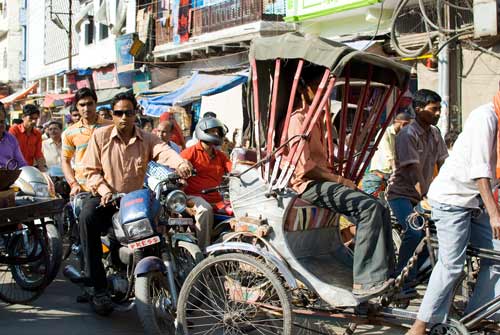
This scene is in Varanasi, but the traffic is like this in all the cities in India we have visited. I cannot imagine what it is like to work as a rickshaw driver in this heady cocktail of fumes every day for years and years, as many do.
The rickshaw in the photo above is a cycle rickshaw, of which there are many, but there are many more auto-rickshaws.
Auto-rickshaws have one wheel at the front and two wheels at the back with a green and yellow plasticized canvas cover stretched over a tubular metal frame.

Some auto-rickshaws run on a two-stroke mixture of oil and gasoline (petrol) and so add their own piquancy to the fumes. If you are not familiar with two-stroke fuel, just know that it belches out more burnt hydrocarbons than a regular car engine does.
Two-stroke autos are banned in some cities in India, but apparently the ban is patchily enforced. The latest models from Bajaj Autos of India run on CNG (compressed natural gas) with a back-up petrol system for what its brochure quaintly describes as “limp home”.
These auto-rickshaws have a starter handle. It looks like a long brake handle located at the side of the driver’s seat.
The driver pulls sharply upwards on the starter handle to start the engine. The handle is of course a variation on the rip cord on an outboard motor.
Auto-rickshaw drivers sometimes turn off their engines when they are stuck in traffic. With two-stroke fuel at 60 rupees per gallon, they have to conserve every drop.
When the traffic gets going again, inches count. The drivers have to be ready to dodge into the first available gap in the traffic. That is when you might see the driver pulling hard and hurriedly on the starter handle so he can get moving quickly.
Apparently, four-stroke models (engines like a regular car has) have an ignition switch as well as a hand starter. if that is true then we have seen only one four-stroke auto-rickshaw in all our travels. That was in Varanasi and the other drivers were so thrilled to show this off that they leaned in where we were sitting and demonstrated it.
Driving Styles In India
The auto-rickshaw drivers are incredibly adept at weaving in and out of traffic, coming so close that often it seems you could not slip a cigarette paper between the vehicles.
If you want to get an idea of how close to each other they drive, imagine that you are parking your car in a parking lot. The attendant asks you to put your car as close to the wall as possible. You back out and drive in again, getting as close as you dare.
The attendant asks you to get closer – really close – and you try again. You feel very uncomfortable doing this because you are sure you are going to scrape the wall.
Eventually your car is near enough to the wall to satisfy the attendant. You get out of the car and walk around to the passenger side to take a look. You lean forward to peer at the space because it seems there is almost no space at all between your car and the wall.
Well, drivers in India drive closer than that. And at speed.
Which Way In Agra
It was in Agra that we had our first experience of how drivers negotiate traffic circles (roundabouts).
They do not go clockwise; they do not go anti-clockwise. They go both ways around the roundabouts. Some go this way and some go that. It is all a matter of choosing an exit point off the traffic circle and weaving a route through the traffic.
Watching from the sidewalk as the drivers negotiate their chosen route is one thing. Sitting in an auto-rickshaw watching cars, bicycles, motor bikes, trucks, and pedestrians zooming up and flying by is another thing entirely.
As you get more used to it, your hand relaxes its tight grip on the framework of the auto-rickshaw, but you move your body a little bit away from the side of the vehicle – just in case.
We read accounts of traffic accidents in the newspapers. Nearly all of them involve people crossing unlit streets and roads at night. We have hardly any reports of other accidents.
Given the number of drivers and the poor protection offered by most vehicles, I would have thought the newspapers would be full of reports if the accident statistics were high.
If this anecdotal evidence is correct and there are not many accidents then it is a testament to the skill of the drivers – because nothing else can save them.
A Final Thought
I am well aware that I am observing the state of the traffic in India through privileged Western eyes. I know that many people in India do not have the luxury of deciding that the situation is too difficult or the traffic pollution too much for them to bear.
Keep checking back for more of our India blog posts!